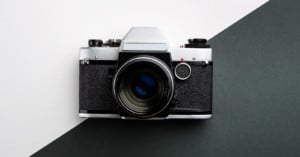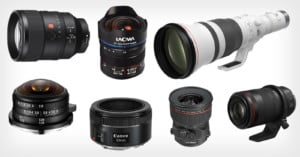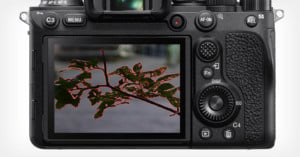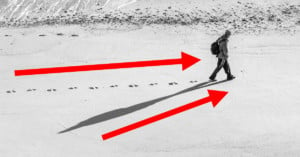
Symmetry in Photography: A Basic Guide for Better Compositions
Wherever you are right now, take a moment to look around. What patterns and shapes do you see? What objects, scenes, buildings, or other designs just look like they “make sense?”

Wherever you are right now, take a moment to look around. What patterns and shapes do you see? What objects, scenes, buildings, or other designs just look like they “make sense?”

With the recent excitement surrounding the release of the film Oppenheimer, there have been lengthy discussions about the best way to watch it – mostly because of something called an aspect ratio and the way that it affects the viewing experience. This is a term that is used widely in film, and it’s just as important for photographers to understand.

Many photographers will say that your camera lens is as important (or even more important) than your camera body. All of the light that your camera body captures has to go through some sort of lens, which affects sharpness, distortion, amount of light, perspective, and many other variables.

One of the most exciting things to photograph is a live concert. Rock concerts in particular have an air of electricity about them that you can feel. When you are hired to photograph one you automatically feel like you are a part of that excitement.

Product photography is a major branch of commercial photography that is ubiquitous in our world, as product photos are used for everything from billboards and print ads to catalogs and store displays. If you'd like to learn how to become a product photographer, you've come to the right place.

Loop lighting is a very common style of portrait lighting that is seen very often in portrait photography. In fact, if you’ve spent much time at all shooting in a studio, you’ve probably employed loop lighting without specifically trying to.

Aerial photography can give viewers a unique perspective that differs from their everyday visual experience, and therefore can bring novelty to an image.

One of the most basic and common terms in the world of photography is the focal length of a lens. In this guide, we will dive down deep into what focal length is and how it works.

An intervalometer is an important tool for photographers that is useful across a range of photography genres and techniques, including timelapses, focus stacking, and long exposures.

We’ve all heard the term "dynamic range" when reading the latest and greatest offerings of camera manufacturers -- "this camera has the highest dynamic range in its category!" We understand that a greater dynamic range is generally a good thing to have.

Photographers use a range of different filters on their camera lenses for different effects and purposes, and one of the most common filters found in a camera bag is the standard UV filter.

If you've ever noticed an unsightly colored fringe or halo on objects in your photographs, you've seen chromatic aberration. It's a common problem in photography and can detract from an otherwise good image. Fortunately, there are ways to minimize or even eliminate it, both before you hit the shutter button and after when editing your picture.

Film photography. It’s coming back, and more and more photographers are dusting off their old film cameras or going out on a search to purchase one. Many people don’t see the appeal and feel quite comfortable with their phone camera. But for others, it’s becoming the only way they create images.

There's more to consider than focal length and price when buying a new lens. Lenses come with an assortment of features such as stabilization and weather sealing, plus issues like distortion and bokeh.

Most digital cameras from the 2000s and 2010s are equipped with an optical element called an optical low-pass filter (OLPF), also known as an anti-aliasing (AA) or blur filter. As the name "filter" suggests, this optical element filters out some information coming from the imaged scene.

In the photographic arms race, mirrorless systems are on the rise, having pushed DSLRs into the history books. But, just as film isn’t dead, neither are rangefinders. This seemingly obsolete design remains sharp, fast, and challenging enough to suit even the most confident photographers.

When compared to the other components of the exposure triangle (shutter speed and aperture), ISO appears to be the most intuitive on the surface. It is also the most misunderstood component, and everything from its definition to its usage has been discussed extensively.

There are many types of camera lenses out there, and it can be a bit confusing and even frustrating trying to sort it out because not every lens will be right for the type of photo you are trying to capture in a particular situation.

As perhaps the most important parameter to understand in photography, shutter speed should be one of your first considerations when making a photograph. It’s one of the biggest reasons that photographers might find themselves unhappy with their shots, and having a great understanding of it is crucial to making great images.

If it seems like there’s more new photography technology than what you can keep up with, you are probably correct. However, don’t let that deter you from learning the industry standards and terms within it. One of those terms that you’ll likely come across is the digital single-lens reflex (DSLR) camera, which has been the leading type of camera for still photography throughout the past decade.

Aperture can seem like one of the most challenging camera settings to fully understand, but once you understand it, your photography will improve immensely.

There is a constant push for faster and lighter technology across different industries, including laptops, smartphones, drones, cameras, and more. In the photography world specifically, mirrorless cameras have appeared on top of the race to overtake DSLR cameras as the industry standard camera for still photography.

It's incredibly satisfying to capture awe-inspiring aerial shots with a drone, and while seeing the world from high above is always intriguing, some pilots make an exciting flight as big of a part of the experience as the beautiful scenery that's being highlighted.

A DNG file is a high-quality image format that is quite common even though it's a relative newcomer compared to some file types such as the TIFF format, which is decades older (2004 vs 1986, respectively).

BeReal is a new social media network that puts a focus on authenticity. Others have made similar claims but this goal has proven difficult to achieve. This guide will look at what BeReal is and how to use it.

One of the most (seemingly) basic tools in Photoshop is the venerable Crop Tool. Used to cut way portions of an image to only leave the desired area, the Crop Tool might appear to be simply a one-trick pony. However, there is a lot more to here than you might think. In this guide, I’m going to break down the various options for making the best use of the Crop Tool.

TIFF is a fairly common file type and is often requested by print agencies since it was made with printing in mind by a company that developed desktop publishing apps. TIFF has been around for a long time and is very versatile, handling black and white, various color spaces, such as CYMK, RGB, and even spot colors with ease.

The trusty tripod has remained relatively unchanged as cameras and lenses become increasingly more advanced and complicated. Sure, manufacturers use increasingly more sophisticated materials, such as carbon fiber, but the fundamental character of the tripod has stood the test of time. A tripod has three legs and is a worthy addition to any photographer's kit. There's not much else to say, is there?

When using manual focus, it’s difficult to tell exactly where your plane of focus is. It’s possible to make a guess using your eye, but you can still be slightly off and end up with an image that is out of focus. Similar to how histograms take the guesswork out of exposure, focus peaking uses an algorithm and a simple visual aid to help take the guesswork out of manually focusing your lens.

In the digital age, there’s a lot more to a photograph than the image itself. When most digital cameras capture an image, they record certain parameters and write them in the image’s file for later use. These parameters are called metadata and are stored as Exchangeable Image File data, or EXIF for short.

If you didn’t believe your grade school math teachers when they said you’d use graphs in the real world, you’re about to. In photography, histograms can seem intimidating, but they are incredibly useful tools that are much easier to understand than they appear. Learning about histograms will help you understand exposure, post-processing, and the overall structure of a photograph.

The period of time when the sun is just below the horizon is commonly referred to as “blue hour,” and comes directly before or after golden hour depending on the time of day. While most people know about golden hour’s benefits for photography, blue hour is often left out when thinking about optimal lighting conditions.

Photographers hear about sensor size all the time, especially when looking to buy a new camera. These include APS-C, Four Thirds, 1", and of course full-frame, the reference format to which all others are compared. But what is a full frame camera and does it make a difference?

“You don't take a photograph, you make it,” Ansel Adams once said. Great point, but let's take it a step further. An important thing to remember is that photographs are just a type of picture, and pictures are made of lines.

The use of strong and complementary colors is an ever-growing trend in photography. Many modern advertising campaigns feature bold and contrasting colors in order to draw your focus to the product or message they are trying to sell. One way to create such vibrant color in your own images is by using colored gels (also known as color filters, filter gels, lighting gels, or simply gels).

If you’ve been outside during a nice sunrise or sunset, chances are good you’ve heard the term “golden hour.” It’s one of the best times to do many types of photography and a beautiful time to be outside. This guide will help you understand golden hour, when it happens, and how to make the most of it through various types of photography.

Globalization certainly has its advantages. Anyone can order almost anything online with a few clicks and have it conveniently delivered to their door regardless of where it is. However, convenience aside, many consumers purchasing things like cameras and lenses may unwittingly be purchasing gray market products rather than "legitimate" ones.

Although I’ve seriously practiced the art of landscape photography for more than two decades, I’ve never questioned the definition of the term. It’s fairly obvious, isn’t it? If I am taking most of my photos outdoors – in the landscape – then I must be a landscape photographer.

A CPL filter, or circular polarizer filter, is a popular and powerful filter that can reduce or eliminate glare and reflections from surfaces in your photographs. In this article, we will introduce this filter type and analyze its use and effects.

Street photography is one of the most popular forms of the art but is also one of the most challenging to perfect. This one-hour-long in-depth video guide was put together to help anyone become a master of the craft.